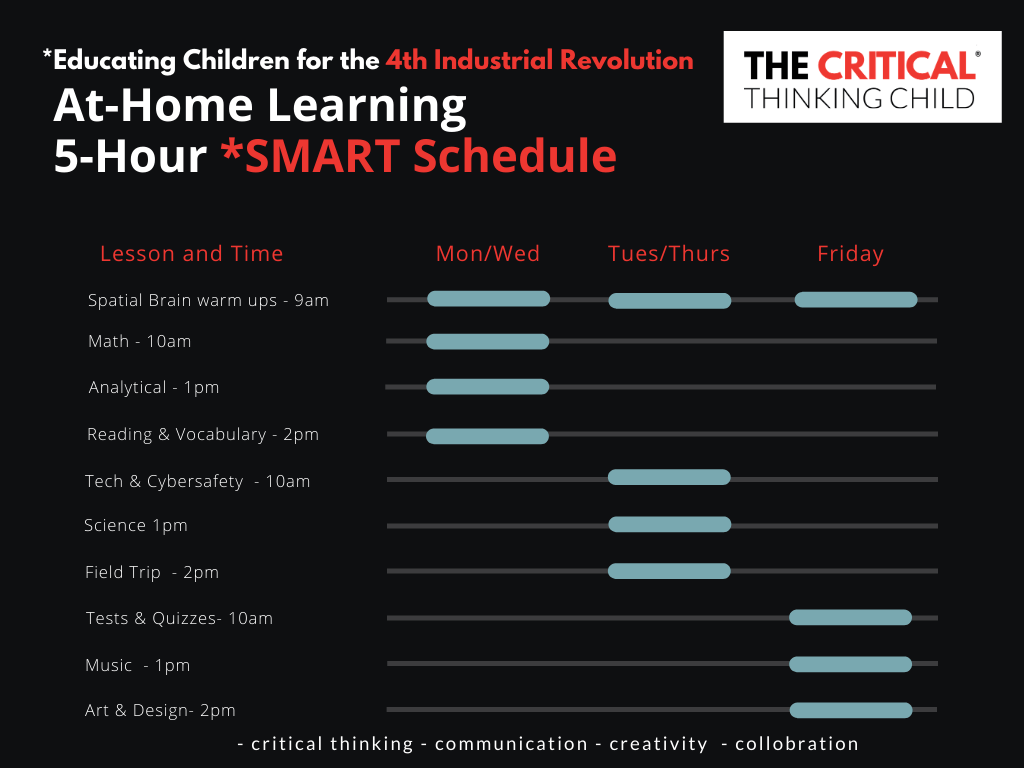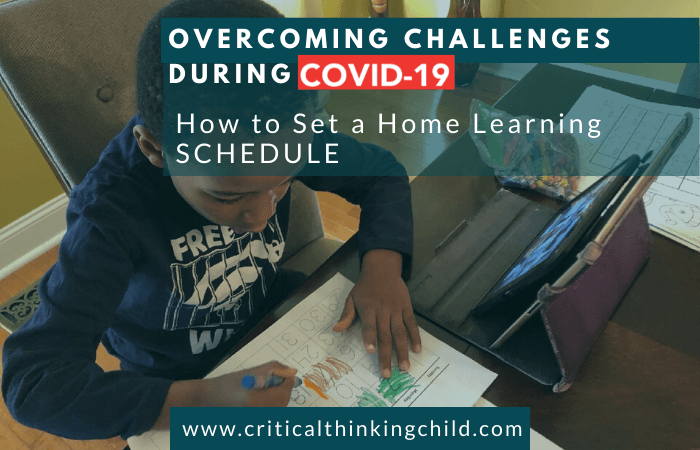With students home from school for the foreseeable future due to the coronavirus pandemic, families are trying to make sense of a new normal. While it can be challenging to create or maintain schedules during these times of education from home, putting in place a consistent routine for distance learning makes the transition easier for everyone. Here we’ll offer some practical tips for keeping your children focused, providing unstructured and creative breaks, and encouraging effective learning at home.
The value of a distance learning schedule comes from striking the right balance between unstructured and structured time. Without structure, your kids may spend entire days on their tablets without any academic progress. On the other hand, too rigorous of an academic routine can also pose problems. If you have your own homeschool curriculum, you’ll need to find the right schedule balance for you.
Here at The Critical Thinking Child, we’ve developed a schedule you can use at home. In addition to focusing on academic prep, it also includes plenty of unstructured time and breaks for physical activity.

Engage in brain warm-ups every day
An effective distance learning schedule doesn’t mean your child sits in “school” all day every day, but it does include some sort of mental warm-up each morning. Fun, easy games that help your child think critically about their world can help them stay on top of other academic work.
We have a number of resources for parents that include fun brain activities that are easy to implement and incredibly effective. Our workbooks guide students through analogies, numbers, lines, shapes, and more.
Treat academic time as a typical school day
Once your child has had a chance to warm up their brain, it’s time to switch gears to academic work. This is the time to dig into specific subject areas and work on helping your child gain confidence in their SMART Skills.
If your child has brought work home from school, now is a great time to dig into those. If you don’t have work from your child’s school or teacher, we offer plenty of alternatives (many of which we’ll be talking about during this Saturday’s webinar on how to support your child’s home learning).
Keep this time to two to three hours daily to avoid burnout. On our provided schedule, we’ve designated different subject areas to different days, allowing your child to take plenty of breaks and engage in unstructured time in the afternoon.
And don’t forget to make it fun! Academic time also includes virtual field trips to places like the Louvre, the San Diego Zoo, and even Mars! Make a plan with your child to go on at least one “field trip” each week. Institutions all over the world offer these tours through their websites.
Embrace unstructured learning opportunities
Unstructured time for education from home can include play-based activities like legos, jigsaw or logic puzzles, or other games, as well as academically-based projects. This time should last at least two hours, but it’s a good idea to extend it longer if your child is particularly engaged.
Allow your child to follow an interest they don’t usually get to spend time on; music, art, and cooking are great areas to explore. This is also a good time to have your child work with real-world problems. They might, for example, work with you to create a family budget or make a map of the backyard to strategize how to plant the family garden.
Unstructured time in your home learning schedule can also include a few household chores. Taking a few minutes to clean and sanitize the home is especially important during this time. Make sure your children understand and practice good hygiene, and let them help you clean, taking special care to wipe down heavily used surfaces as well as door knobs and handles.
Don’t neglect physical activity
Many experts recommend at least 30 minutes of physical activity both in the morning and in the afternoon. An easy way to do this is by planning a family walk or hike (so long as you’re allowed to go outdoors). If the weather doesn’t cooperate, or if you’re advised to stay inside, yoga or a quick exercise video (or dance break!) will do the trick.
These physical breaks are essential to allow your children some time without academic pressure. They will also increase your child’s focus when they return to studying. Find a time of day and activity that works for your family and stick with it!
Learn More About How to Create a Distance Learning Schedule During Coronavirus Related School Closures
No matter how you schedule your day, end home learning at the time your child would normally leave school. Enjoy each other’s company, and have dinner as a family, spending your evenings as you normally would.
Keeping the non-school parts of your day consistent will restore a sense of normalcy for you and your children. Download our Ultimate Education Guide, which will dig into more tips for parents on how to academically support children during the coronavirus outbreak.



